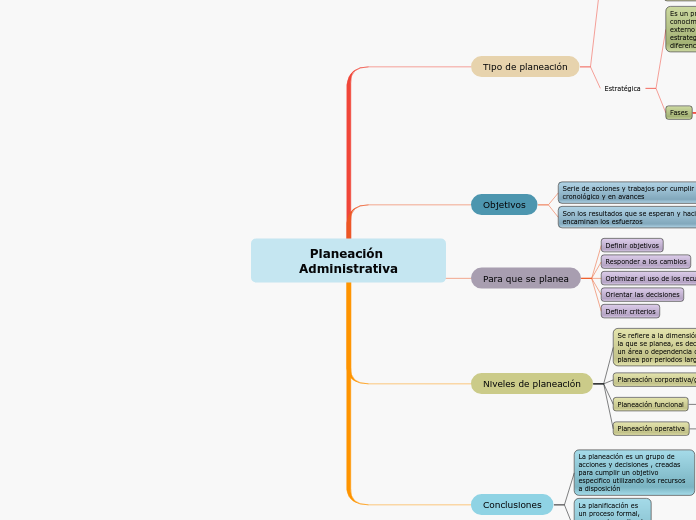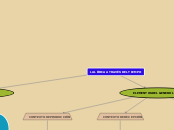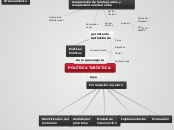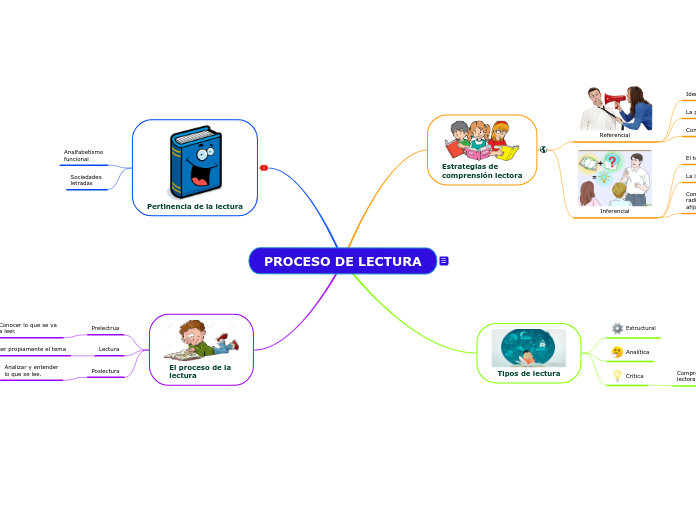Planeación Administrativa
To name your story, you have to think about the overall message and what you want your audience to understand from the story. Also, make it relevant and easy to remember.
Conclusiones
La planificación es un proceso formal, aunque dependiendo del campo de acción también puede ser informal y de base empírica
La planeación es un grupo de acciones y decisiones , creadas para cumplir un objetivo especifico utilizando los recursos a disposición
Niveles de planeación
Planeación operativa
Define los diferentes cargos operativos ( tiempo de día a día)
Planeación funcional
Desarrollada para areas o departamentos de una empresa (mediano plazo)
Planeación corporativa/grandes empresas
Tiene un tiempo considerado es decir a largo plazo(4 a 5 años)
Se refiere a la dimensión y horizonte de tiempo para la que se planea, es decir la planeación se ha para un área o dependencia o cargo en particular o si se planea por periodos largo, mediano, corto plazo.
Para que se planea
The ending of a story is essential. We all know that if the ending is weak, what happened before loses its importance. So make it unpredictable, but fair. A resolved ending answers all the questions and ties up any loose threads from the plot.
Definir criterios
Orientar las decisiones
Optimizar el uso de los recursos
Responder a los cambios
This is the closure section of the story.
See examples of possible outcomes below:
- all problems have been solved
- it's clear how each one of your characters ends up
- your main character is transformed by the challenge
Definir objetivos
This is the moment when the main character surpasses the last obstacle and finally faces their greatest challenge.
The climax usually follows one of these patterns:
- realization
- resolution
- choice
Type in your answer.
Objetivos
The middle of the story is where you add layers of complications that will lead to the end. Reveal more about the character's journey. Did their personality go through changes? How did they overcome the challenges? And as you build up the story’s central conflict, make it more personal to that character. Also, from the middle act, you have to lead into the final act.
Son los resultados que se esperan y hacia el cual se encaminan los esfuerzos
Your character(s) need(s) motivation in order to solve the challenge(s).
Serie de acciones y trabajos por cumplir en orden cronológico y en avances
Each story has a main character and that character usually needs to solve a problem or challenge. The character's challenge is the one that creates tension throughout the story.
Tipo de planeación
In the beginning of the story (or the exposition), you will need to introduce the setting and characters. You might also want to introduce the main conflict. This part of the story is important because it gives the reader necessary background information and maybe even a first insight into a character’s personality.
Estratégica
The setting (time & place) of a story can change throughout the plot.
Fases
The time of the story can also change. It can describe the event of a single day or can include an entire year's plot. Anyway, don't forget to mention it.
Toma de decisiones sobre estrategias y acciones
Elaborar análisis competitivo
Elaborar análisis estratégico
Elaborar diagnostico y objetivos
Realizar análisis interno
Realizar análisis externo
Establecer visión y misión
Es un proceso sistemático fundamentado en un conocimiento riguroso de su entorno interno y externo de esta manera formular objetivos y estrategias que le permitan a cada organización diferenciarse y ser más competitivas.
Your story can take place wherever your imagination will take you to.
For example: in an elevator, in an enchanted forest, etc. Don't forget to give details of the environment each time the setting changes, otherwise, the story can be confusing. Also, mention the seasons as each of them has unique weather and events.
Tradicional
Characters are essential to a good story. Usually, the protagonist(s) is/are the most affected by the plot. Introduce a character by focusing on their actions, interests, and occupation, as the physical appearance doesn't make a difference in most cases.
Se basa en un horizonte de tiempo
Define objetivos en determinado tiempo, comunica al personal para trabajar en lograrlo.
Type in the name of your character.










